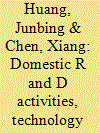|
|
|
Sort Order |
|
|
|
Items / Page
|
|
|
|
|
|
|
| Srl | Item |
| 1 |
ID:
171519


|
|
|
|
|
| Summary/Abstract |
Domestic research and development (R&D) activities are critical for the development of China's low-carbon economy. The higher level of R&D inputs, the more advanced technology will generate, therefore contributing to the energy intensity reduction. In empirical studies, the effect of R&D activities on energy intensity has been investigated extensively, however, most studies consider R&D activities as a whole. Consequently, we lack detailed information on the role of each R&D player and stage for appropriate policy consideration. Furthermore, the effects of R&D activities may be determined by factors affecting technology absorptive ability. To understand the influence of R&D activities on energy intensity, we employ linear and nonlinear analyses using a Chinese provincial dataset covering 2000–2016. The linear analysis suggests that domestic R&D is powerful in reducing energy intensity. However, this positive effect is mainly from experimental and developmental R&D activities rather than basic R&D and application activities. Further, R&D activities by industrial enterprises have a stronger effect on energy intensity reduction than those of higher education and independent R&D institutions. Additional study using panel threshold models suggests that the effects are not linear but experience structural breaks when human capital stock and full-time equivalent (FEP) R&D personnel are at different levels.
|
|
|
|
|
|
|
|
|
|
|
|
|
|
|
|
| 2 |
ID:
170100


|
|
|
|
|
| Summary/Abstract |
This study investigates the effects of technological factors, including indigenous research and development (R&D) investments, technology spillovers coming from foreign direct investments, export, and import, on China's total factor productivity (TFP). Using provincial panel data of China, covering 30 provinces over the period 2000–2014, our results confirm that indigenous R&D investments play a leading role in promoting TFP. Linear analysis suggests that, except for export, the technology spillovers through openness are beneficial for TFP growth. However, a further discussion based on a panel threshold model suggests that the different behaviours of these technology spillovers are dependent on the technological absorptive capacity affecting factors, such as human capital and indigenous R&D investments. The human capital will strengthen the spillover effects of each technology spillover. However, R&D intensity initially tends to hamper their spillover effects. Once the R&D intensity exceeds a certain level, the negative spillover effect of export on TFP tends to be alleviated, and the positive spillover effect of foreign direct investment and import on TFP will increase.
|
|
|
|
|
|
|
|
|
|
|
|
|
|
|
|
|
|
|
|
|